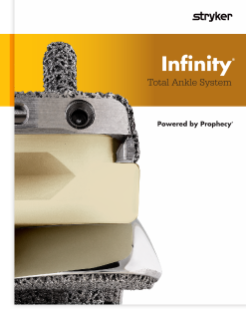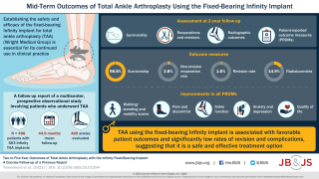Infinity®
Total Ankle System

The Infinity® Total Ankle System consists of a titanium alloy tibial tray, cobalt chromium talar dome, and polyethylene insert. Celebrating 10 years of international clinical use, Infinity has become one of the most widely used1 low-profile prosthesis solutions for surgeons treating End Stage Ankle Arthritis (ESAA).
Options for the Infinity Total Ankle System include an Adaptis® 3D printed porous metal tibia tray, a chamfered or flat cut Adaptis talar dome and the Everlast® Highly Cross linked polyethylene insert. All components are available in varying sizes to better match patient anatomy.
Celebrating 10 years
of the Infinity Total Ankle System
Since the initial launch of the Infinity Total Ankle in 2014, this low-profile total ankle replacement implant has become the leading total ankle prosthesis choice by surgeons in the US & the UK.1,2
- Over 48,000 implanted worldwide3
- Market leader in the United States1
- Approved in 33 countries globally4

In the largest prospective study of a single total ankle prosthesis to date, Infinity Total Ankle System published 98.8% survivorship at two years.5
Full visualization of bone
Implant interface
The Infinity prosthesis was purposefully designed without tibial flanges or barrels and without talar dome side walls that could obscure fluoroscopic imaging.
By allowing complete visualization of the implant interface, the surgeon can verify thorough seating of the talar prosthesis. This important feature also facilitates the visibility of X-rays for post-op follow up.

The Infinity Total Ankle System consists of Adaptis 3D printed, porous metal tibia tray, the option of a chamfered or flat cut Adaptis talar dome, and the Everlast Highly Cross-linked polyethylene insert. All components are available in varying sizes to best match patient anatomy.
Talar options for the Infinity Total Ankle System include a low-profile chamfered or flat cut style talar dome allowing surgeon preference to dictate. Both are available in 3D printed porous Adaptis metal and all components are available in varying sizes to best match patient anatomy.
The Infinity Total Ankle System features the same sulcus articular geometry as Inbone Total Ankle system. A coronally stable design that may help reduce dependency on surrounding soft tissues.

Adaptis technology
Adaptis® material is 3D printed as a single, monoblock construct, which reduces the possibility of delamination at the solid/porous material interface.

In-growth as early as 4 weeks
Adaptis 3D-printed, in-growth surface design.6
3D-printed metal components

Improve long term fixation
Adaptis® 3D printed, porous metal components are designed to act as a scaffold that facilitates boney ingrowth as early as 4 weeks.6
Increase initial stability
Increased initial implant stability through greater friction at the bone to implant interface.7
Improve wear resistance
Everlast® highly cross-linked polyethylene inserts improve wear resistance by up to 26%.8

Contact us
Send us a message to learn more about Infinity Total Ankle System
Have questions or inquiries? We’re here to help! Fill out the contact form, and our dedicated team will get back to you promptly. Your feedback and inquiries are important to us, and we look forward to assisting you with any information or support you may need.
Are you a patient looking for more information or a physician in your area?
Click the button below for our patient website.
References
- Based on SmartTrak Data as of 2023
- Based on UK NJR Annual Report 2023
- Based on internal sales data
- Based on countries where Infinity is approved by the governing regulatory body
- Townshend D, Bing A, Blundell C, Clough T, Davenport J, Davies H, Davis J, Dhar S, Hepple S, Kakwani R, Karski M, Makwana N, McKinley J, Murty A, Raglan M, Shalaby H, Sharpe I, Smith R, Taylor H, Goldberg A. Two to Five-Year Outcomes of Total Ankle Arthroplasty with the Infinity Fixed-Bearing Implant: A Concise Follow-up of a Previous Report. J Bone Joint Surg Am. 2023 Dec 6;105(23):1846-1856. doi: 10.2106/JBJS.22.01294. Epub 2023 Oct 16. PMID: 38063779; PMCID: PMC10695343.
- Data on file at Stryker. Claim based on data from rabbit femure model. It is unknown how these results compare with clinical results in humans.
- Zhang Y, Ahn PB, Fitzpatrick DC, Heiner A, Poggie RA, Brown TD, Interfacial frictional behavior; cancellous bone, cortical bone, and a novel porous tantalum biomaterial. Journal Musculoskeletal Research 1999.
- When compared to Stryker traditional ankle UHMWPE poly inserts through bench top testing according to ISO 22622. Data on file.
AP-017646


